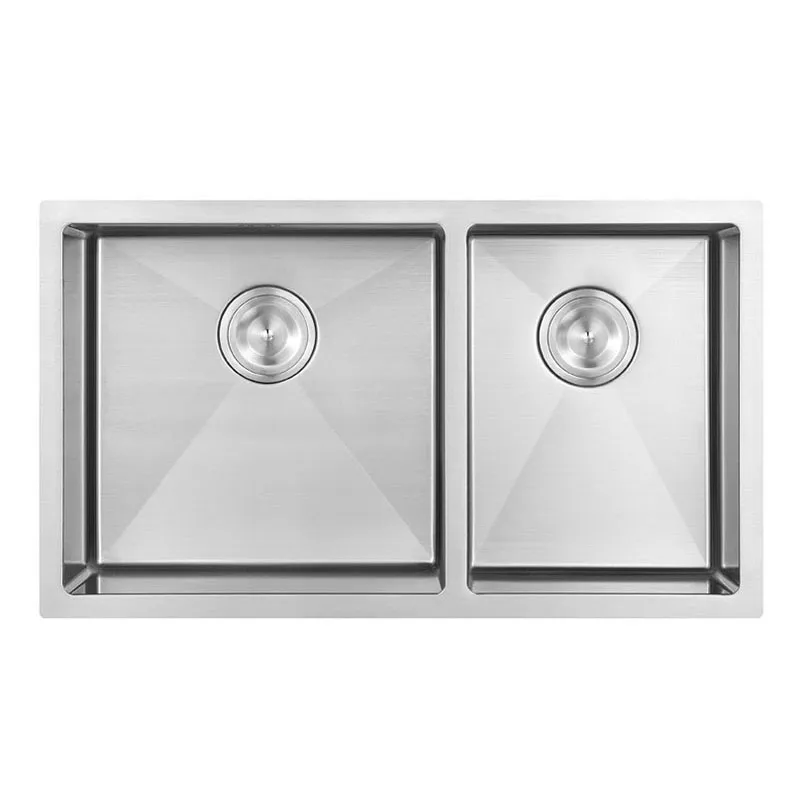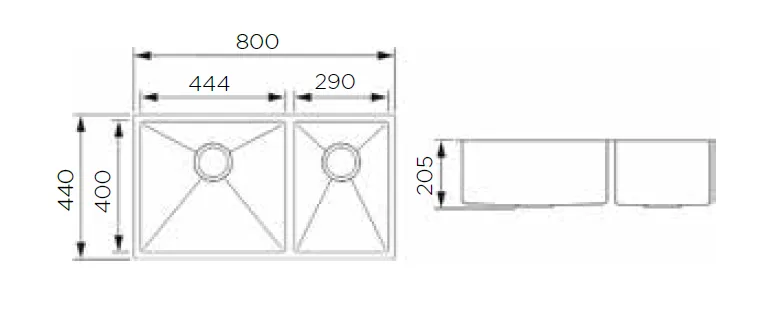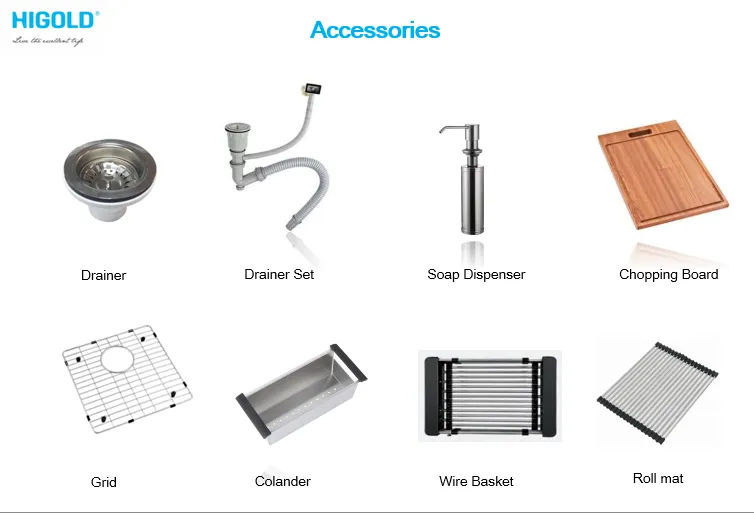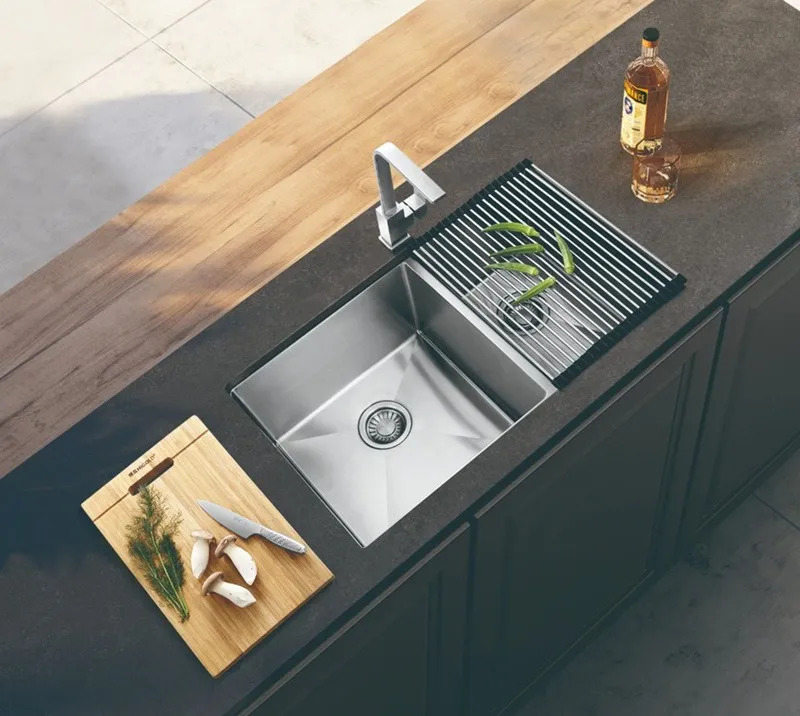In modern kitchen design, the sink is undoubtedly one of the most important components. Double bowl kitchen sinks are becoming increasingly popular in home kitchens due to their flexibility and efficiency. Whether in a home or commercial kitchen, double bowl sinks provide more space and convenience, helping users complete daily cleaning and cooking tasks more efficiently.
However, when choosing and installing a double bowl kitchen sink, a key consideration is the required space.
This article will delve into the space required for a double bowl sink in the kitchen, helping you better understand how to choose the right double bowl sink for your kitchen and ensure a smooth sink installation.

What is a double bowl kitchen sink?
A double bowl kitchen sink generally refers to a kitchen sink with two bowls. Depending on the design, a double bowl sink can have different compartments, such as two equal-sized bowls or two bowls with different sink sizes. Common configurations include two equal-sized sinks or a combination of one large and one small sink. Double bowl sinks are typically designed to improve kitchen efficiency, allowing users to perform multiple washing tasks simultaneously, such as washing vegetables, dishes, and pots, eliminating the frequent switching of items or separate tasks required with a single-bowl sink.
What are the advantages of a double bowl sink?
Compared to single-bowl sinks, double bowl sinks provide more space. Users can divide different washing tasks between sinks, preventing cross-contamination and improving kitchen efficiency. The advantages of a double bowl sink include:
• Improved efficiency: Multiple washing tasks, such as washing vegetables, dishes, and soaking pots, can be performed simultaneously, eliminating the need to wash everything in a single sink.
• Improved hygiene: Cross-contamination can be avoided, for example, by washing raw meat separately from vegetables.
• Saved time: Multiple tasks can be performed simultaneously, reducing waiting time.

What are the dimensions of a double bowl kitchen sink?
Choosing the right size for a double bowl kitchen sink is crucial to ensuring smooth installation and operation. Choosing the right sink size depends on several factors, such as kitchen size, household needs, and sink design. Below are some important size requirements and recommendations.
1. Standard Dimensions of Double Bowl Sinks
Common double bowl kitchen sinks on the market are typically sized by width. The width of the sink directly affects the space required for installation. Double bowl sinks typically range in width from 60 cm to 80 cm. Common sizes include:
• 60 cm: This size is suitable for smaller kitchens, providing ample workspace without taking up too much countertop space.
• 70 cm: Suitable for medium-sized kitchens, providing ample workspace while maintaining sufficient flexibility.
• 80 cm: Suitable for larger kitchens, it can accommodate a larger sink and is ideal for families with larger families and frequent kitchen use.
In addition to width, sink depth is also an important factor to consider. Common double bowl sinks range from 18 cm to 25 cm. Deeper sinks offer more storage space, can accommodate more items, and are suitable for families with frequent sink use. However, it is important to note that sinks that are too deep may affect the user's height and comfort level.
2. Installation Space Height Requirements
The installation height of a double bowl sink is generally determined by the height of the kitchen countertop. Typically, the countertop is 85-95 cm high, and the sink should be installed flush with the countertop. Installing the sink too high or too low can be inconvenient and affect cleaning and operation comfort.
Also, the space required for a double bowl sink should take into account the requirements for plumbing, drains, and other connections. When installing the sink, ensure that the drainage system is unobstructed to avoid poor drainage or inconvenience caused by insufficient space.
3. Sink Layout and Design
Double bowl kitchen sinks come in various layouts, including the following:
• Equal-width double sinks: Both sinks are equal in width, suitable for users who frequently perform tasks between the two sinks.
• Large/Small double sinks: One large sink is suitable for large pots and pans, while the other is for washing dishes. This layout is suitable for households that need to handle different cleaning tasks.
When designing a double bowl sink, users should choose the appropriate layout based on the size of their kitchen and their specific needs. Generally speaking, a double-bowl kitchen sink should be designed to provide ample space for both sides to operate, avoiding inconvenience caused by a cramped space.

How much space is needed to install a double-bowl sink in the kitchen?
1. Compatibility of Countertop Width and Double-Bowl Sink
To ensure a smooth installation of a double-bowl sink, the countertop width must be wide enough to accommodate the sink. When installing a double-bowl sink, the countertop width should be at least 10 cm wider than the sink to ensure a secure placement while leaving ample space for operation.
For example, if you choose a 70 cm wide double-bowl kitchen sink, the countertop width should be at least 80 cm or wider. This ensures a secure installation and provides the necessary space for maintenance and cleaning.
2. Distance from the Sink to the Wall
When installing a double-bowl kitchen sink, the distance between the sink and the wall must also be considered. Generally speaking, a minimum distance of 2-3 cm should be maintained between the sink and the wall to ensure proper drainage and plumbing connections. Too little spacing can make installation difficult and affect the sink's subsequent use and cleaning.
In addition, when installing a double bowl kitchen sink, ensure sufficient space for plumbing and drainage to avoid leaks or poor drainage during subsequent use.
3. Installation Depth Requirements
The installation depth refers to the required space under the sink. Generally speaking, the sink needs to be deep enough to accommodate the plumbing and drainage pipes. During installation, ensure the sink depth meets the overall kitchen design requirements so that the installer can smoothly connect the drainage pipes.

How to Measure and Plan the Installation Space for a Double Bowl Sink?
Accurate measurements and space planning are crucial when selecting and installing a double bowl kitchen sink. Here are some basic steps to follow when installing a double bowl sink:
1. Measure Countertop Space
First, ensure there is enough space on the kitchen countertop to accommodate the double bowl sink. Use a tape measure to measure the width and depth of the countertop to ensure it can accommodate the selected double bowl kitchen sink size. Also, leave enough space for the drainage pipes and water pipes.
2. Reserve Installation Space
When installing a double bowl sink, ensure adequate clearance between the sink and the surrounding countertop, typically at least 5-10 cm. This ensures a secure fit after installation and facilitates cleaning and maintenance.
3. Drainage System Layout
Ensure the double bowl kitchen sink's drain pipes connect smoothly. Design a suitable drainage pipe layout based on the sink's location and drain height to avoid blockages and poor drainage.
Does Higold offer PVD-coated stainless steel sinks?
Yes, Higold's professional PVD facility produces stainless steel sinks in stylish finishes such as gold, gunmetal, and matte black. These sinks offer a premium appearance with excellent durability. PVD-coated products are popular in high-end retail markets and can be ordered in customized batches for private labels or promotional sales.


